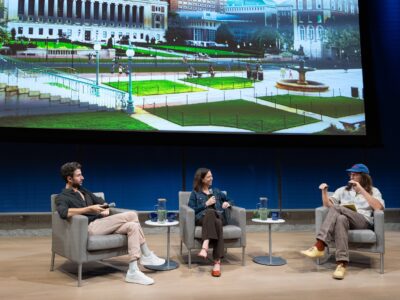
On Thursday I’ll be attending Illuminating the Science: Art and Climate Change. The event’s project is surely ambitious. It claims not only that climate data might be better communicated, or made more robust, through the arts, but that indeed “the landscape of numbers can be populated by dreams in the form of images, dance or music, leading to a more complete understanding of how out planet works.”
I was initially skeptical that such an ambitious project could ever really be achieved. My gut reaction says that climate science and the arts are two different languages which are ontologically distinct and perhaps in some ways contradictory. In general, science trades in currencies of typically numerical data. Climate scientists observe natural phenomena and quantify them into languages that are readily translated, analyzed, and disseminated to other scientists and science writers. In this socially discursive project, science seeks “objectivity.” Art, at least some of it, seeks to transcend or deconstruct objectivity, challenging dominant social mores in ways that are usually highly subjective, or inherently critical (and hence, political). The arts and climate science are both socially produced artifacts, but do different things for different reasons and to different ends.
But thinking about this a little deeper, I reflect upon what art and climate science are doing: interpreting the world around us, and in doing so constructing meanings. That is, when we interpret the “natural world” through climate science, or the “natural” (or social) world through art, we assign new meanings to what we are interpreting. Without science, we wouldn’t know to say droughts or floods might be influenced by El Nino — we just wouldn’t have that meaning assigned to a drought. Climate science, therefore, makes the world intelligible in a new way.
Likewise, art embarks on its own projects of interpretation and communication. I think it’s true that art can make the human experience more robust, at the very least in the ways in which it plays with forms, materials, sounds, and ideas. The process of making, disseminating, and interpreting art is, like science, another way of making the world around us intelligible and understandable. We wouldn’t know that an everyday object like a bicycle wheel or urinal could be given meaning outside of their utility without art. The bicycle wheel could not be made intelligible in that way.
I see in the non-human world a great degree of phenomena that are simplyunquantifiable; I don’t doubt some of my scientist friends might disagree! But, in “leading to a more complete understanding or how our planet works,” it seems to me that art can fill in some of the gaps that happen when the world is quantified through science, some of the losses of translation. My suspicion is that rather than being two contradictory media, art and science might really be complementary. I am really excited (and very lucky!) to get to put these speculations to the test on Thursday’s event.




[…] week I expressed some skepticism that art and climate science were complementary languages. I also expressed some hope that the […]